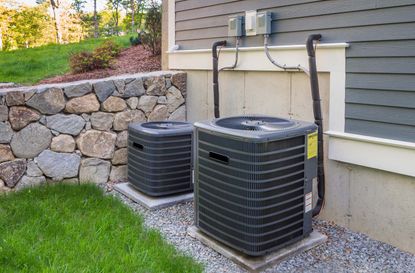6 Things You Must Know About Home Cooling Bills
Some simple steps can help you hold down the cost of beating the heat.


1. Costs remain high. Despite lower overall fuel costs, the U.S. Energy Information Administration forecasts that the average residential electricity bill this summer will be $400 or more. Air-conditioning is the biggest culprit. Take some of the load off your AC with light-filtering window treatments, and replace incandescent lightbulbs with cool LEDs (about $12 to $20 for a six-pack). Using a ceiling fan instead of, or along with, your air conditioner can keep you comfortable while allowing you to raise the thermostat. Just turn the fan off when you leave the room. Fans are designed to cool people, not spaces.
2. Care for your compressor. Dirt and debris can plug up your unit. Check for a buildup of grass or leaves, and change indoor fan filters in the spring and again in midsummer, says John Jones, national technical director at the Building Performance Institute. And instead of waiting until your AC fails in 100-degree weather, call in a professional to service your unit. At minimum, a technician should check refrigerant levels and inspect and clean all components. Go to www.acca.org/homes for advice on finding a reputable contractor.
3. Turn up the temp. "By maintaining the highest comfortable setting, people can save up to 30% of their summer cooling costs," says Tim Pettit, spokesman for Duke Energy, which provides gas and electricity in the Southeast and Midwest. Try to ease into a comfort range of 76 to 78 degrees F. A programmable thermostat ($35 to $50; smart thermostats, such as Nest, run about $200), which can turn on your AC before you come home and turn up the thermostat overnight, can save you up to 10% on heating and cooling costs a year, according to the Department of Energy.

Sign up for Kiplinger’s Free E-Newsletters
Profit and prosper with the best of expert advice on investing, taxes, retirement, personal finance and more - straight to your e-mail.
Profit and prosper with the best of expert advice - straight to your e-mail.
4. Get a thank-you from your local utility. See if your electric company offers a summer pricing plan. For example, Pepco, which provides power in the Mid Atlantic region, offers participants in its peak-demand program $40 to $80 in bill credits, prorated over the five months of the cooling season, for allowing it to cycle their AC on and off. Or you may earn a rebate for an energy-efficient upgrade to your home, such as tuning up your heating and cooling.
5. Apply for a tax break. If your air conditioner has reached the end of its life (typically about 15 years), you may qualify for a federal tax credit of up to $300 in 2016 for replacing it with an Energy Star-rated unit that meets certain criteria. For more information, go to www.energystar.gov.
6. If all else fails . . . Still not seeing a significant difference in your bill? Consider calling in a home energy auditor ($200 to $1,000, depending on where you live and the size of your house). You may, for example, need to seal ducts in your attic or crawl spaces, or your insulation may need an upgrade. "An auditor is not just looking for things that hit your bottom line, but potential health and safety problems related to indoor air quality," says Jones. Your utility may offer such a service, or look for a professional certified by Energy Star, the Building Performance Institute (www.bpihomeowner.org) or the Residential Energy Services Network (www.resnet.us).

-
 It’s Tax Day: Is the Post Office Open Late?
It’s Tax Day: Is the Post Office Open Late?Tax Filing Tax Day is here and some people need to mail their federal income tax returns.
By Kelley R. Taylor Published
-
 Need to Build an Emergency Fund? Seven Steps to Get There
Need to Build an Emergency Fund? Seven Steps to Get ThereHaving a safety net can mean peace of mind on top of being able to maintain your lifestyle if a financial emergency strikes.
By Justin Stivers, Esq. Published
-
 403(b) Contribution Limits for 2024
403(b) Contribution Limits for 2024retirement plans Teachers and nonprofit workers can contribute more to a 403(b) retirement plan in 2024 than they could in 2023.
By Jackie Stewart Published
-
 Roth IRA Contribution Limits for 2024
Roth IRA Contribution Limits for 2024Roth IRAs Roth IRA contribution limits have gone up for 2024. Here's what you need to know.
By Jackie Stewart Published
-
 Best Foreclosure Sites for Finding Properties
Best Foreclosure Sites for Finding PropertiesMaking Your Money Last Wondering how to find foreclosed homes for sale for your next residence or to flip for a profit? These websites will guide you to foreclosures and real estate-owned properties to buy.
By Bob Niedt Last updated
-
 Luxury Home Prices Rise as the Rich Dodge High Mortgage Rates
Luxury Home Prices Rise as the Rich Dodge High Mortgage RatesLuxury home prices rose 9% to the highest third-quarter level on record, Redfin reports, growing nearly three times faster than non-luxury prices.
By Kathryn Pomroy Published
-
 Four Tips for Renting Out Your Home on Airbnb
Four Tips for Renting Out Your Home on Airbnbreal estate Here's what you should know before listing your home on Airbnb.
By Miriam Cross Published
-
 Five Ways to a Cheap Last-Minute Vacation
Five Ways to a Cheap Last-Minute VacationTravel Procrastinator? No matter. You can pull off a fun and memorable getaway on a moment's notice — without breaking the bank.
By Vaishali Varu Last updated
-
 How Much Life Insurance Do You Need?
How Much Life Insurance Do You Need?insurance Instead of relying on rules of thumb, you’re better off taking a systematic approach to figuring your life-insurance needs.
By Kimberly Lankford Published
-
 When Is Amazon Prime Day?
When Is Amazon Prime Day?Amazon Prime In 2023 Amazon had two Prime Day events — one in July and another, called Big Deal Days, in October. We expect 2024 to follow the same schedule.
By Bob Niedt Last updated